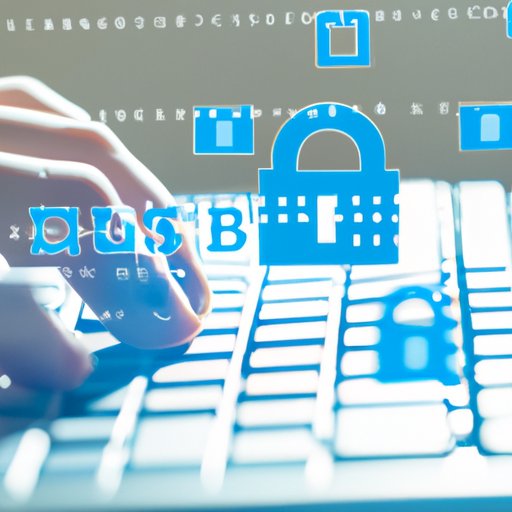Introduction
Cybersecurity is an ever-evolving field that is essential for protecting our personal information, data, and online activities from malicious attacks. It is a combination of technologies, processes, and practices designed to protect systems, networks, and programs from digital attacks. In today’s increasingly interconnected world, it is important to understand the basics of cybersecurity and how to protect yourself against cyber threats.
Basics of Cybersecurity
When it comes to cybersecurity, there are many different types of cyber threats that can be used to attack individuals, businesses, and governments. These threats include malware, phishing, ransomware, and distributed denial of service (DDoS) attacks, among others. It is important to know the various types of threats and how to protect against them.
Malware is a malicious software program that is designed to damage or disable computer systems. Phishing is a type of social engineering attack where attackers use emails or other communication channels to try to get victims to provide sensitive information, such as passwords or credit card numbers. Ransomware is a type of malware that encrypts files on a computer and then demands payment for the decryption key. DDoS attacks are when attackers flood a website or network with requests, resulting in the website or network being unavailable.
To protect against these threats, it is important to use secure passwords and set up two-factor authentication. Secure passwords should be long, complex, and unique, and should not be shared with anyone. Two-factor authentication adds an extra layer of security by requiring users to enter a code sent to their mobile phone or email address in addition to their password.
Creating a Secure Password and Setting Up Two-Factor Authentication
Creating a secure password is an important step in protecting your online accounts. A strong password should be at least 8 characters long, contain upper and lowercase letters, numbers, and symbols, and should not be a word found in the dictionary. It should also be unique and not used for any other account. Additionally, it is important to update your passwords regularly and never share them with anyone.
Two-factor authentication is a security measure that requires users to enter a code sent to their mobile phone or email address in addition to their password. This adds an extra layer of security and helps prevent unauthorized access to accounts. It is recommended that users enable two-factor authentication for all online accounts.
Real-World Examples of Successful Cybersecurity Implementations
There are many real-world examples of successful cybersecurity implementations. Governments around the world have adopted strategies to protect their citizens from cyber threats. For example, the United Kingdom has launched a Cyber Security Strategy to protect government networks, critical national infrastructure, and businesses from cyber-attacks. The strategy includes initiatives such as the National Cyber Security Programme and the Cyber Essentials Scheme.
Corporations have also implemented cybersecurity measures to protect their networks and data. Companies like Microsoft, Google, and Apple have implemented encryption protocols and other security measures to protect customer data. Additionally, some companies have implemented two-factor authentication for additional security.
Individuals also have a responsibility to protect themselves against cyber threats. This includes using secure passwords, updating passwords regularly, and enabling two-factor authentication. Additionally, users should be aware of potential scams and phishing attempts, and should avoid clicking on suspicious links or downloading unknown files.
Current Trends in Cybersecurity
The cybersecurity industry is constantly evolving as new technologies are developed and new threats emerge. Artificial intelligence (AI) and machine learning are two emerging technologies that are being used to detect cyber threats and respond quickly to attacks. Additionally, cloud computing is becoming increasingly popular as a way to store data securely and protect it from cyber-attacks.
Biometrics, such as fingerprint scanners and facial recognition, are also becoming more common as a way to authenticate users. Additionally, blockchain technology is being used to create secure networks and protect data from cyber-attacks.
“We need to continue to develop innovative technologies and strategies to stay ahead of cyber criminals,” said Michael Chertoff, former Secretary of the Department of Homeland Security. “It’s not enough to just put up a wall; we need to be proactive in our approach to cyber security.”
Conclusion
Cybersecurity is an ever-evolving field that is essential for protecting our personal information, data, and online activities from malicious attacks. It is important to understand the basics of cybersecurity and how to protect yourself against cyber threats. This includes using secure passwords, setting up two-factor authentication, and staying up to date with the latest trends in the industry.
Government initiatives, corporate strategies, and individual responsibilities all play a role in creating a secure online environment. By understanding the basics of cybersecurity and staying up to date with the latest developments, individuals, businesses, and governments can protect themselves against cyber threats.
Summary of Key Points
- Cybersecurity is a combination of technologies, processes, and practices designed to protect systems, networks, and programs from digital attacks.
- Different types of cyber threats include malware, phishing, ransomware, and distributed denial of service (DDoS) attacks.
- Creating a secure password and setting up two-factor authentication are important steps for protecting your online accounts.
- Governments, corporations, and individuals all have a responsibility to protect themselves against cyber threats.
- Emerging technologies such as artificial intelligence (AI), machine learning, cloud computing, biometrics, and blockchain are being used to improve cybersecurity.
Resources for Further Learning
- US-CERT – Tips for Protecting Your Online Accounts
- Department of Homeland Security – Cybersecurity Strategy
- Microsoft – Cybersecurity Basics
- Forbes – The Top 7 Cyber Security Trends You Need to Know in 2019
- U.S.
(Note: Is this article not meeting your expectations? Do you have knowledge or insights to share? Unlock new opportunities and expand your reach by joining our authors team. Click Registration to join us and share your expertise with our readers.)
